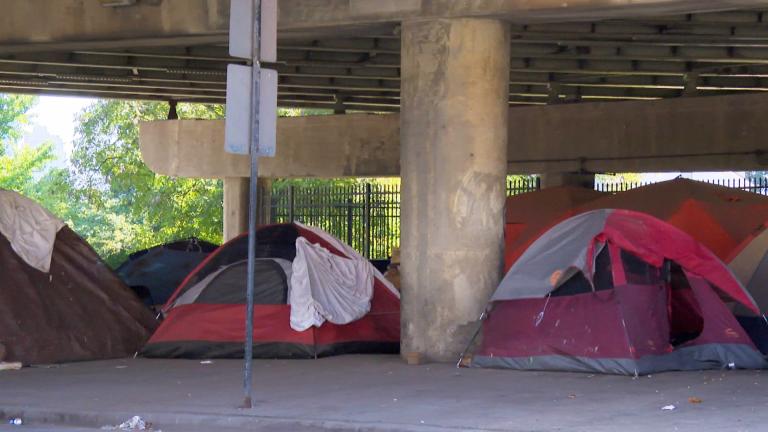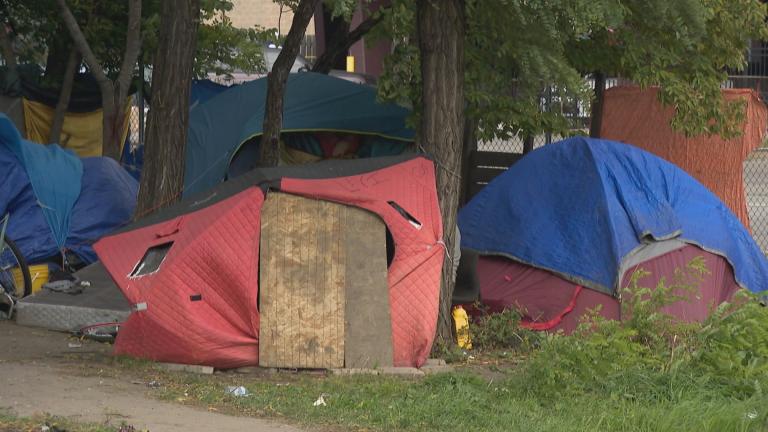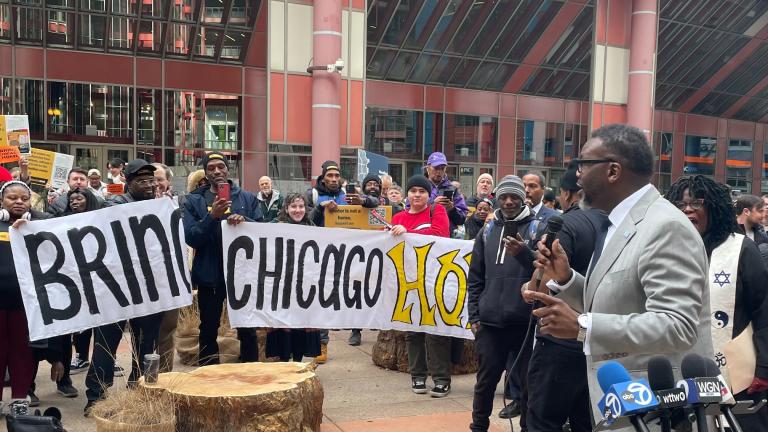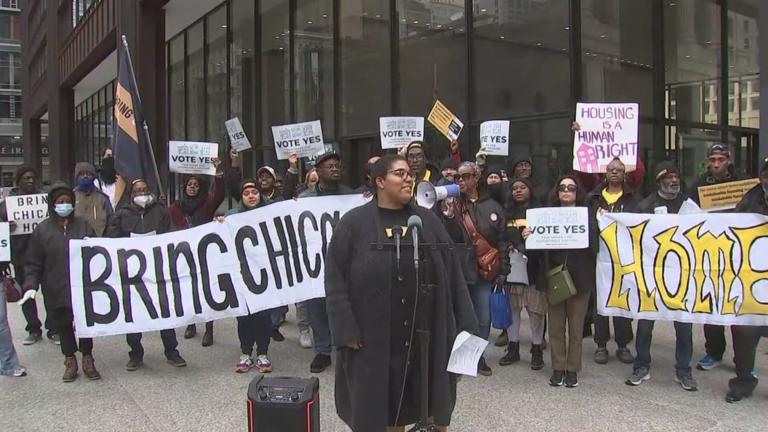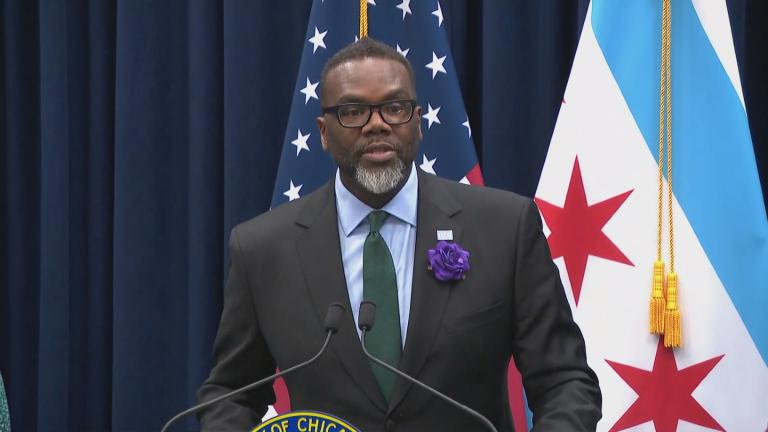WTTW is spending a year focused on the challenging experiences and unique perspectives of unhoused people across Chicago in “FIRSTHAND: Homeless.”
One morning in late January, outreach workers on a Blue Line train went from car to car, checking on people who use the CTA system as shelter.
“Good morning,” one of the workers said to a person sitting in the small compartment near the door to the next car. The worker said she was with Haymarket Center and asked, “You OK?”
That person quickly dismissed the workers, but one of them offered a snack and an orange juice and took notes about the engagement on a clipboard. Then she moved on to the next person who appeared to be sheltering on the train.
The workers are part of an outreach program led by the Haymarket Center and Thresholds, social service agencies tapped by the CTA and the city’s Department of Family and Support Services as part of a $2 million agreement signed in late 2022.
That agreement led to a plan to take homeless outreach efforts onto the CTA's two 24-hour routes: the Red and Blue lines. Another $2 million was approved by the transit agency to continue the pilot program this year.
Caseworkers MG Hibionada and Ell Fabricius talk to a person on the Red Line about shelter options. Fabricius and Hibionada are members of the Thresholds team on the CTA, which provides outreach and services to people sheltering on the trains. (Kathleen Hinkel / Block Club Chicago)
Officials say their goal for the program is straightforward: to increase the number of people connected to shelter and housing.
The program has already helped dozens of people into “better situations,” one CTA official said. But many more still use the transit system for shelter. The agency’s latest count, in 2022, found 564 people sheltering on trains and other CTA property, according to a 2023 report.
Outreach program leaders say they need more resources to sustain their efforts and time to assess what’s working.
In the first nine months of 2023, outreach workers had more than 5,000 interactions with people using CTA trains as shelter. Many interactions ended with people indicating they didn’t want to talk further.
Caseworker Ell Fabricius talks to a person at the North/Clybourn Red Line stop about shelter options. (Kathleen Hinkel / Block Club Chicago)
Of those who interacted with the program, 122 people were placed in shelters, 27 were connected to “stable or permanent housing destinations” and 20 were housed through an event at Harold Washington Library set up specifically for people reached through the CTA initiative.
The program “got the ball rolling in the right direction,” said Ali Simmons, a senior case and outreach worker in the Chicago Coalition for the Homeless’ Law Project.
But he cautioned that addressing homelessness more broadly is “definitely going to take a lot more outreach, primarily because of the … magnitude of the problem.”
“It's definitely within our best interest to be able to reach these people, know where they are, know what they need, know how to try to help them navigate their situation,” Simmons said. “The drawback is there's not enough housing. … Without that component of it, it's like we're continuing to do outreach with the same people over and over again.”
‘We Had To Take More Steps To Address The Situation’
In the years leading up to the pandemic, much of the outreach around the CTA focused on engaging with people coming off the train or sheltering before the turnstiles, said Tom McKone, the CTA’s chief administrative officer.
And because the outreach was largely done during business hours, it wasn’t consistent or ongoing.
 A homeless person’s belongings sit in a shopping cart and trash bag at the Jefferson Park Blue Line station on Jan. 31, 2023. (Colin Boyle / Block Club Chicago)
A homeless person’s belongings sit in a shopping cart and trash bag at the Jefferson Park Blue Line station on Jan. 31, 2023. (Colin Boyle / Block Club Chicago)
The current program was created because “it was clear that we had to take more steps to address the situation” during and after the pandemic, McKone said.
“Individuals sheltering on the CTA don't want to be sheltering there,” McKone said. “These are our homeless brothers and sisters.”
While the number of people experiencing homelessness has fluctuated over the past five years, the city saw its highest estimate in 2023, at 6,139 people. That figure came from a “Snapshot of Homelessness in Chicago,” which is based on a count taken on one night every winter. Of that number, 990 were living on trains or in other areas “not meant for human habitation.”
Neither of those figures likely represents the total number of people experiencing homelessness.
The nonprofit Chicago Coalition for the Homeless puts the number over 68,000. That includes people who are “doubled up,” living in the homes of family or friends.
CTA and city officials decided they needed to do more.
McKone said CTA leaders talked to the Department of Family and Support Services and to transit agencies across the country, including in New York and Philadelphia, about other approaches to help people experiencing homelessness.
They concluded they should have outreach workers on the trains. The Support Services department suggested enhancing outreach with some of the providers the city already works with to “really meet the population where they’re at,” McKone said.
Haymarket and Thresholds were brought in after that to carry out the work of the program. Both organizations have extensive track records of working with people experiencing homelessness who may also have substance use or mental health disorders.
As part of the CTA-based program, Haymarket focuses on the Blue Line between the O’Hare and Clark/Lake stations while Thresholds handles the Red Line.
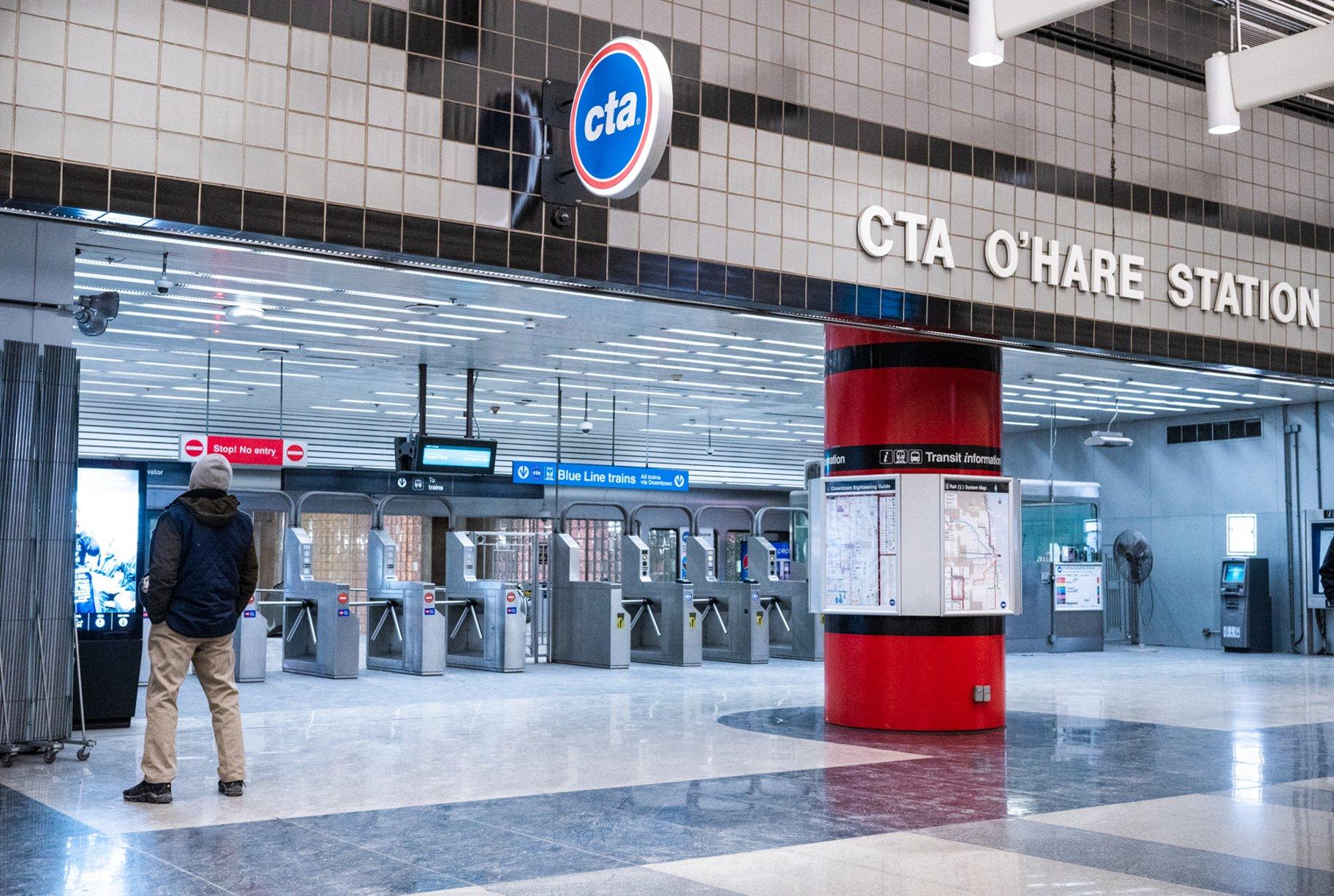 The Blue Line station at O’Hare Airport on Jan. 31, 2023. (Colin Boyle / Block Club Chicago)
The Blue Line station at O’Hare Airport on Jan. 31, 2023. (Colin Boyle / Block Club Chicago)
To create the train-focused outreach plan, those organizations developed an approach that tries to recognize “all of the broad reasons that contribute to people's homelessness,” said Jessica Dubuar, Haymarket's director of health and specialty services.
”There isn't just one type of service that is going to help our patients get moved from homelessness to housing,” so outreach workers, housing placement teams and other programs “are coordinating together,” Dubuar said.
Caseworkers Ell Fabricius and MG Hibionada look for a person they regularly check in with at the North/Clybourn Red Line stop. (Kathleen Hinkel / Block Club Chicago)
Haymarket and Thresholds are tasked with checking on shelter availability throughout the day. Connecting people to shelter and to housing are the program’s guiding principles, or “North Star goals,” CTA officials stated at their November 2023 meeting.
Outreach teams on the trains work in shifts to engage with people and help them connect to shelter, medical care or agencies that help them get IDs and other documents.
Those schedules were planned around times of day when people are more likely to use the trains for shelter, like the late evening into the early morning, said Sam Guardino, Thresholds’ area director of homeless services.
Teams also parked a couple of vans along the line to take people to an overnight shelter and had team meetings in the hours when shifts overlapped to ensure people who requested services, like ID cards or other shelter placement options, could be connected to them quickly.
Those coordination efforts created a “bigger impact than expected,” Guardino said. For example, more people were willing to move from the CTA to an overnight shelter, he said.
“We aren't prescriptive, we aren't telling people how to live their lives, but we are trying to build a relationship and then help people identify their needs and see what they want to work with us on,” Guardino said.
Program Faces Challenges Beyond Its Control
Now in its first full winter season, the pilot program is primarily focused on engaging people and connecting them to resources.
The outreach teams have found that most people sheltering on the trains don’t want to engage much. Those who do most often ask for food, hygiene products, or help getting into the city’s shelter system or longer-term housing, documents received through a public records request show.
Workers take notes, logging their interactions and requests from people on the CTA, and share summaries of their work with officials as part of their approach to assessing the program.
Caseworker Ell Fabricius talks to a person at the North/Clybourn station about shelter options. “We aren’t prescriptive, we aren’t telling people how to live their lives,” said a Thresholds program director. (Kathleen Hinkel / Block Club Chicago)
Along with successful connections to shelter and housing, officials want to see growth in the numbers of requests for shelter, even if people aren’t successfully placed; food or other services provided; and enrollments in systems to track homelessness and connect people to assistance.
McKone said the pilot phase of the program will show officials “what we could learn, how much we could address the situation and what else we might want to take away from it as we move towards addressing the homeless situation on CTA.”
One of the main obstacles to the agency doing that work on its own is the amount of federal funding available, McKone said.
“I'm hopeful that through this pilot program in Chicago … that they'll be able to identify and help sort of address and reduce those barriers so that the resources can be put where they’re really needed,” McKone said.
But to get more people into permanent housing, the city needs more housing options, those who spoke to WTTW News and Block Club Chicago said.
That includes more affordable and supportive housing for those who “have other issues in their lives that they need support with,” McKone said.
Simmons’ organization, the Chicago Coalition for the Homeless, is leading the effort to pass the ballot initiative Bring Chicago Home.
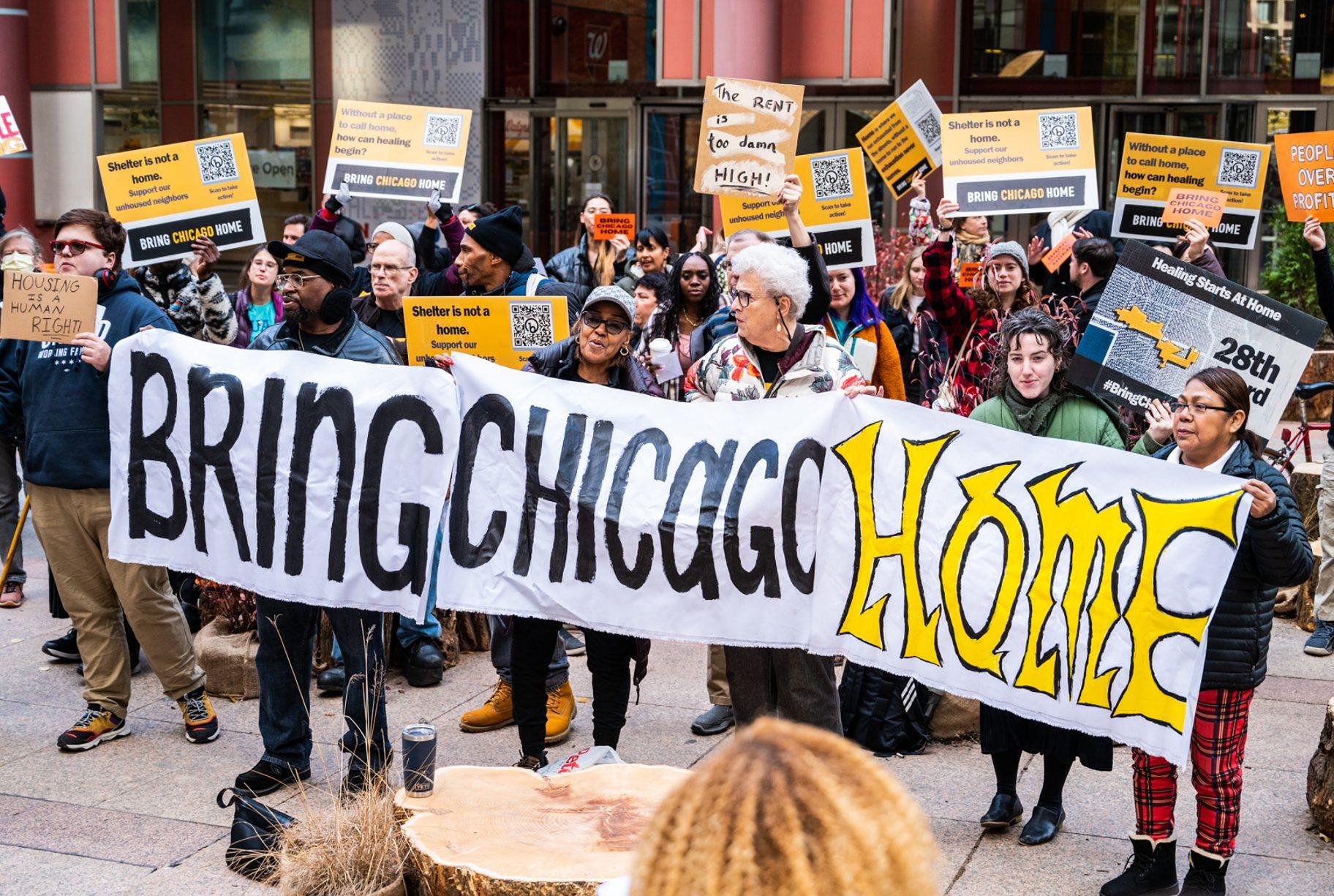 Dozens rally outside the Thompson Center for the Bring Chicago Home ballot initiative before a City Council meeting on Nov. 7, 2023. (Colin Boyle / Block Club Chicago)
Dozens rally outside the Thompson Center for the Bring Chicago Home ballot initiative before a City Council meeting on Nov. 7, 2023. (Colin Boyle / Block Club Chicago)
The measure, which will come before Chicago voters in March, would usher in a tiered increase in the tax rate buyers pay on property sales over $1 million. The money would be dedicated to providing permanent affordable housing and wraparound services for people who are unhoused.
Opponents of the measure have said the increase would further hurt an already struggling commercial real estate sector.
But without more funds dedicated to addressing homelessness, “it's like we're going through the same thing each and every year,” Simmons said.
“Budgets are thin, there’s not enough money to do this, not enough money to do that, and oftentimes homelessness is overlooked for other things.”
Housing advocates say programs like the one staffed by Thresholds caseworkers Ell Fabricius (left) and MG Hibionada are essential to helping the city’s homeless population. (Kathleen Hinkel / Block Club Chicago)
Officials and outreach workers believe they’ve made progress in the first year of the CTA program. They hope it’s extended.
Without the program, McKone said, people who have found housing “would still be sheltering on the CTA, but today, they're not.
“They're in better situations, they're in more productive situations,” McKone said. “And that's a direct result of this agreement.”

